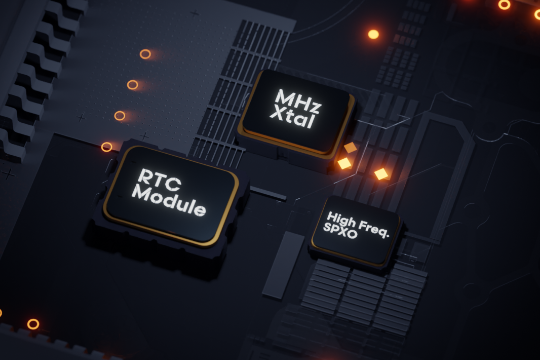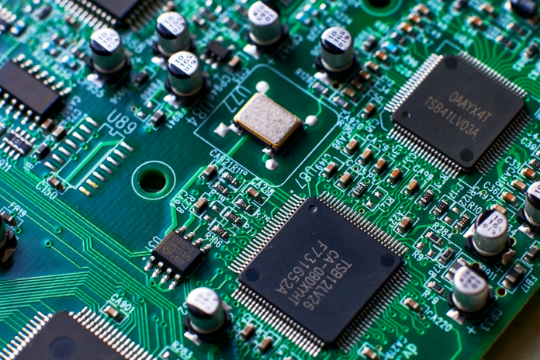What is a Crystal Oscillator? Principles and Mechanisms, Difference Between a Crystal Oscillator and a Crystal Unit, and Tips for Choosing the Right Ones for You
What is a Crystal Oscillator?
A crystal oscillator is an electronic component consisting of a crystal unit and an oscillator circuit integrated in a single package. Crystal oscillators generate a stable frequency and output a regular reference signal.
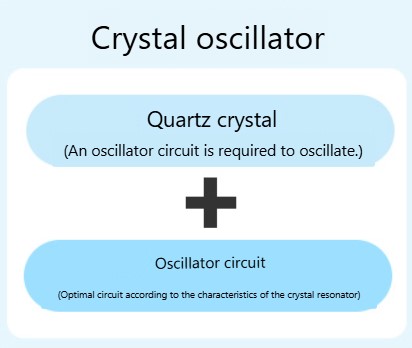
Model Diagram of a Crystal Oscillator
Principles and mechanisms
To cause a crystal unit to oscillate, a crystal oscillator needs to have an oscillator circuit that is matched to the characteristics of the crystal unit. The motion of a crystal unit is analogous to that of a pendulum. To cause a pendulum to continue swinging back and forth, you must detect the pendulum’s position and time of maximum swing and apply a force to constantly push the pendulum back to that position and time. The oscillator circuit is responsible for this detection and the force used to push the “pendulum” back at a constant energy.
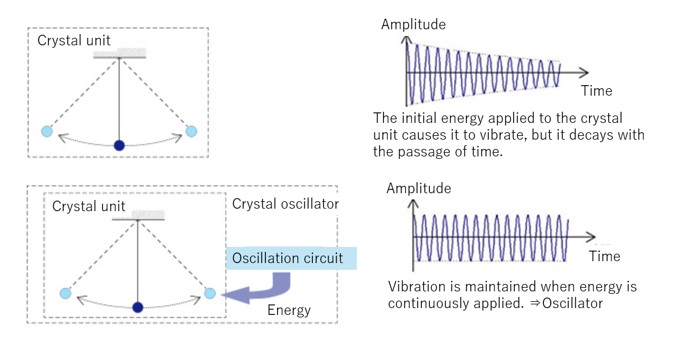
Crystal Oscillator Principles
Structure of a crystal oscillator
As stated above, a crystal oscillator is an electronic component consisting of a crystal unit and an oscillator circuit (IC) integrated in a single package. The structure of the package is illustrated below.
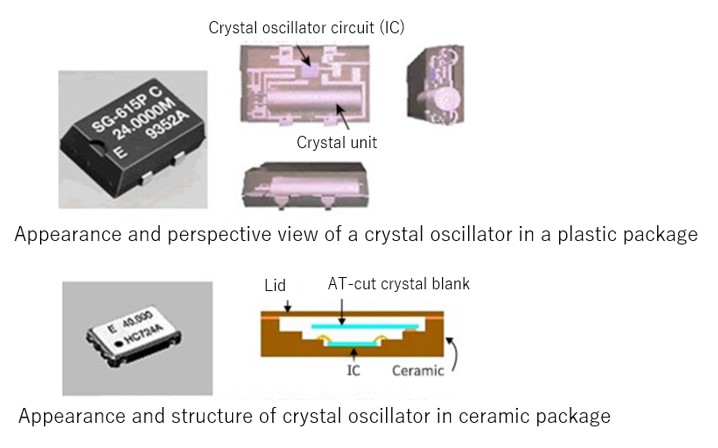
Main applications for crystal oscillators
Crystal oscillators, known for their precision and stability, are used especially in applications requiring high accuracy. As one of the electronic components that control frequency, they are often used to provide frequency and time references. For example, they are used as frequency signal sources in communication equipment, industrial equipment, and automotive equipment, as timing clocks in watches, and as clock sources in digital circuits.
What is a Crystal Unit?
A crystal unit is a device (a resonator) that uses the piezoelectric effect of quartz crystal to generate a constant frequency. The crystal unit is like the pendulum in a pendulum clock; it does not operate on its own. To keep the pendulum moving continuously, it is used in combination with an IC and other components.
Vibration modes, cut orientations, and frequency/temperature characteristics
The vibration mode is determined by the direction in which the crystal chip (blank) is cut from the rough quartz crystal. Among the common angular cuts are the AT cut, BT cut, and X cut, but the AT cut is the most common because of its high stability within a normal temperature range.
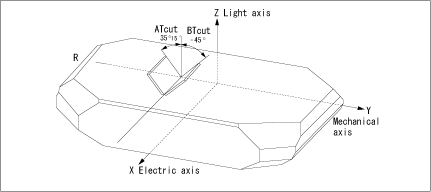
Cut Orientation in the Z Plane of a Synthetic Quartz Crystal
The graphs below schematically show the cut angles at which the first-order temperature coefficient of the frequency/temperature characteristic near room temperature is zero for AT-cut and BT-cut crystals.
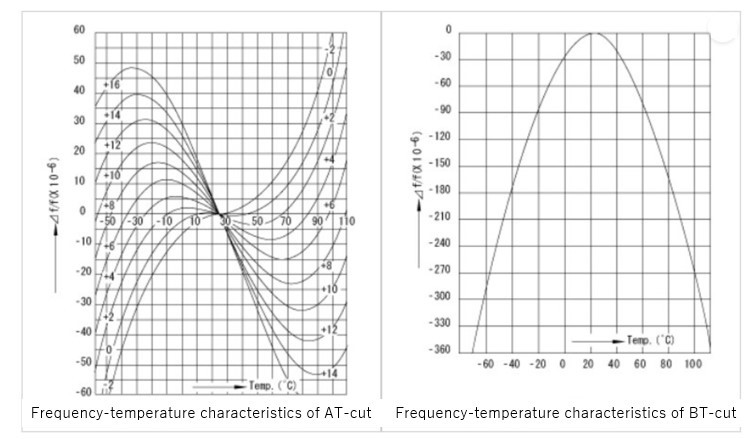
Equivalent circuits and constants
A crystal unit can be represented as an equivalent circuit like that picture below in the vicinity of the resonance frequency.
R1: Series resistance
L1: Motional inductance
C1: Motional capacitance
C0: Shunt capacitance
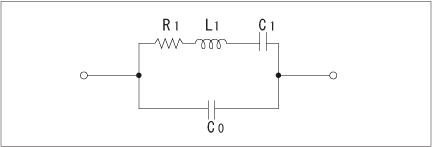
Equivalent Circuit of a Crystal Unit
Characteristics of the equivalent circuit parameters of a crystal unit
| Equivalent series resistance R1 | Represents losses, including losses due to internal friction within the crystal unit, mechanical losses of the electrodes and support system, and acoustic losses due to ambient environmental conditions |
| Motional inductance L1 | A large value that is difficult to obtain in other electrical circuits |
| Motional capacitance C1 | A very small value, opposite to L1 |
| Shunt capacitance C0 | Stray capacitance between holder and electrodes or between support systems, and capacitance between the electrodes |
Differences between crystal units and crystal oscillators
A crystal unit is a quartz crystal chip with piezoelectric properties housed in a specialized container. A crystal oscillator is a device that houses in a single package both a crystal unit and an oscillator circuit to make the crystal oscillate. The oscillator circuit must be matched to the crystal unit used. If the crystal unit and the oscillator circuit are not matched, the crystal will not produce the desired frequency, or oscillation may stop altogether. Crystal oscillators come with an optimally matched oscillator circuit built in, so design engineers can easily obtain a stable oscillation frequency without having to evaluate the match themselves. Epson develops, designs, and fabricates its own ICs and grows and processes its own crystals. This enables us to perfectly match the characteristics of both to achieve outstanding frequency stability.
Tips for Choosing the Right Crystal Oscillator and Crystal Unit
Considerations for choosing a crystal oscillator and crystal unit are outlined below.
Oscillation frequency and frequency stability
Can the desired oscillation frequency be produced?Do they have a frequency stability that satisfies the system’s requirements, including temperature characteristics, etc.?
Load capacitance of the crystal unit
Is the load capacitance of the crystal unit compatible with the load capacitance of the oscillator circuit?
Supply voltage of the crystal oscillator
Does it match your supply voltage?
Types of Crystal Oscillators and Their Features and Applications
Crystal oscillators are divided into several types depending on their configuration and accuracy.
Simple packaged crystal oscillators (SPXOs), and their features and applications
An SPXO is a type of crystal oscillator that provides stable frequency output without temperature compensation or temperature control. Housing an oscillator circuit along with either an AT-cut crystal unit or a tuning fork crystal unit in the same package, an SPXO is designed and manufactured to output a stable signal when a specified supply voltage is applied to it. Typical accuracy ranges from ±20 to ±100 ppm depending on the temperature range. These oscillators are used in a variety of applications and markets.
Temperature compensated crystal oscillators (TCXOs), and their features and applications
A TCXO is a temperature-compensated crystal oscillator designed to enhance frequency stability by incorporating a temperature compensation circuit. This circuit makes it less susceptible to external environmental temperature changes, resulting in greater accuracy than an SPXO. Generally, the accuracy is at the level of a few ppm. TCXOs are often used for reference signals in wireless communications and in network applications.
Voltage-controlled crystal oscillators (VCXOs), and their features and applications
A VCXO is a voltage-controlled crystal oscillator that includes a voltage-controlled variable reactance element, such as a varactor diode, in its oscillation loop. This allows the output frequency to be adjusted according to the set voltage. VCXOs are increasingly used as slave oscillators in phase-locked loops (PLLs) and as frequency modulators. A crystal oscillator that combines a VCXO and TCXO is called a VC-TCXO. These have the advantage of allowing fine frequency adjustments electrically. The absolute variable range of a VCXO is generally 50 ppm, while the absolute variable range of a VC-TCXO is at the level of a few ppm.
Programmable crystal oscillators, and their features and applications
A programmable crystal oscillator is an oscillator with a PLL circuit. As the name suggests, it can be programmed to output a desired frequency. The programmability means that these oscillators can be acquired with a shorter lead time than oscillators written with common output frequencies.
Features of Epson’s programmable oscillators
Epson has two main types of programmable oscillators.
1) Programmable oscillators
These crystal oscillators can be programmed, allowing for short lead times, small lot sizes, and support for non-standard frequencies. A dedicated tool is used to write any output frequency ranging from 0.67 MHz to 170 Hz. Our programmable oscillators, and those in our SG-8101 series, in particular, incorporate an Epson IC and are accurate within ±15 ppm. Please see the links to the product pages below for details.
General purpose oscillators
SG-8018CB (Size: 5.0 x 3.2 mm)
SG-8018CE (Size: 3.2 x 2.5 mm)
SG-8018CG (Size: 2.5 x 2.0 mm)
High accuracy
SG-8101CB (Size: 5.0 x 3.2 mm)
SG-8101CE (Size: 3.2 x 2.5 mm)
SG-8101CG (Size: 2.5 x 2.0 mm)
SG-8101CGA (Automotive, Size: 2.5 x 2.0 mm)
+125℃compatible with low jitter
High precision & low jitter for automotive applications
2) Programmable oscillators with spectrum spread function
In addition to the basic functions of programmable oscillators, Epson offers a series of programmable oscillators with a spread spectrum function. This function is effective as a countermeasure against electromagnetic noise. By modulating the frequency over a specific frequency domain relative to the output frequency, this feature can suppress the peaks of the fundamental wave and harmonics spectrum, thereby reducing EMI. These oscillators can also be purchased with short lead times and in small quantities, making them suitable for cases where specific non-standard frequencies are needed or during prototyping. Please see the links to the product pages below for details.


